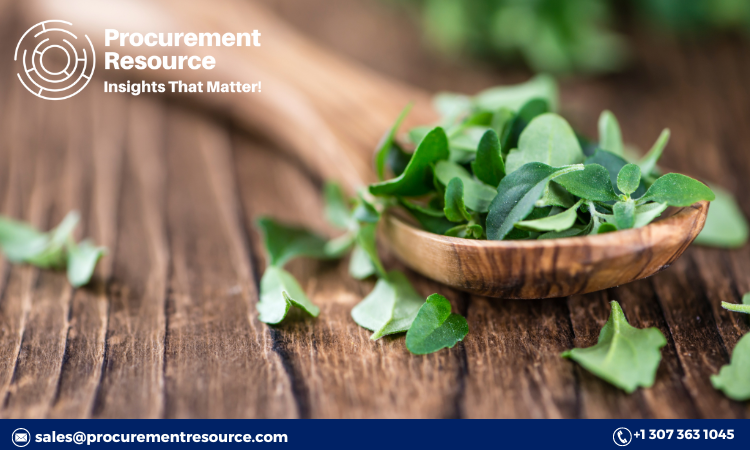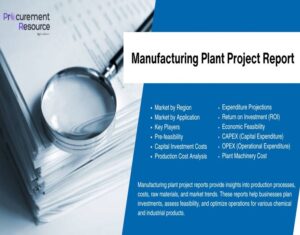
Menthol is a widely used organic compound that imparts a cooling sensation, making it a popular ingredient in various products, including cosmetics, pharmaceuticals, and food. Extracted primarily from peppermint oil, menthol can also be synthesized artificially. The production process of menthol involves several steps, each requiring careful control and precision to ensure the quality and purity of the final product. This report delves into the various methods of menthol production, the associated manufacturing processes, raw material costs, and the latest developments in the industry.
Manufacturing Report and Process
Natural Extraction
Menthol can be extracted from peppermint oil through a process of fractional distillation and crystallization. The steps involved in the natural extraction process are as follows:
- Harvesting Peppermint: The production process begins with the cultivation and harvesting of peppermint plants. The plants are typically harvested when the essential oil content is at its peak.
- Extraction of Peppermint Oil: The harvested peppermint plants are subjected to steam distillation to extract the essential oil. The oil is then separated from the water and other plant residues.
- Fractional Distillation: The peppermint oil undergoes fractional distillation, where it is heated, and the vapors are collected at different temperatures. Menthol, being one of the components, is separated based on its boiling point.
- Crystallization: The menthol-rich fraction is cooled to form crystals. These crystals are then filtered and purified to obtain high-purity menthol.
Request For Sample: https://www.procurementresource.com/production-cost-report-store/menthol/request-sample
Synthetic Production
In addition to natural extraction, menthol can also be synthesized through chemical processes. The synthetic production of menthol involves several key steps:
- Hydrogenation of Thymol: Thymol, a compound derived from m-cresol, is hydrogenated in the presence of a catalyst to form racemic menthol, which is a mixture of different isomers of menthol.
- Resolution of Racemic Mixture: The racemic menthol mixture is then separated into its individual isomers. The desired isomer, (-)-menthol, is isolated and further purified.
- Purification: The isolated menthol is subjected to various purification techniques, including recrystallization and distillation, to ensure its high purity and quality.
Raw Material Costs
The cost of raw materials is a significant factor in the overall production cost of menthol. The primary raw materials used in the production of menthol are:
- Peppermint: For natural extraction, the cost of cultivating and harvesting peppermint plants is a major component. The price of peppermint oil can fluctuate based on factors such as weather conditions, crop yield, and market demand.
- Thymol: In synthetic production, thymol is a key raw material. The price of thymol is influenced by the availability of m-cresol and other petrochemical derivatives used in its synthesis.
- Catalysts and Chemicals: The hydrogenation process in synthetic production requires catalysts, which can be expensive. Other chemicals used in purification and separation processes also contribute to the overall cost.
- Energy and Utilities: Both natural and synthetic production methods require significant amounts of energy for distillation, hydrogenation, and crystallization processes. The cost of energy and utilities, such as electricity and steam, is an important consideration.
- Labor and Overheads: Labor costs, including skilled technicians and workers, as well as overhead costs related to maintaining production facilities, also impact the overall cost of menthol production.
Latest News
The menthol production industry is continuously evolving, with new developments and advancements shaping the market. Some of the latest news and trends in menthol production include:
Sustainable Production Methods
With increasing environmental concerns, there is a growing focus on sustainable and eco-friendly production methods. Researchers are exploring ways to reduce the carbon footprint of menthol production by optimizing energy usage and minimizing waste.
Biotechnology Advancements
Advancements in biotechnology are opening up new avenues for menthol production. Genetic engineering techniques are being developed to create peppermint plants with higher menthol content, potentially increasing yield and reducing production costs.
Market Demand and Supply Dynamics
The demand for menthol is influenced by its widespread use in various industries, including pharmaceuticals, cosmetics, and food. Recent market trends indicate a steady increase in demand, driven by the growing popularity of menthol-based products. However, supply chain disruptions and fluctuations in raw material availability can impact the market dynamics.
Regulatory Changes
Regulatory changes and standards play a crucial role in menthol production. Recent updates in regulatory frameworks, particularly in the pharmaceutical and food sectors, have led to stricter quality control measures. Producers need to comply with these regulations to ensure product safety and marketability.
Innovations in Synthesis Techniques
Innovations in chemical synthesis techniques are being explored to improve the efficiency and yield of synthetic menthol production. New catalysts and reaction pathways are being developed to enhance the selectivity and purity of menthol isomers.
Investment in Research and Development
Leading companies in the menthol production industry are investing heavily in research and development to stay competitive. These investments aim to discover new methods, improve existing processes, and develop novel applications for menthol.
Conclusion
The menthol production process, whether through natural extraction or synthetic methods, involves a series of complex and carefully controlled steps. Understanding the intricacies of the manufacturing process, raw material costs, and the latest industry developments is crucial for producers to remain competitive and meet the growing demand for high-quality menthol. With ongoing advancements and a focus on sustainability, the future of menthol production looks promising, offering new opportunities for innovation and growth in this essential industry.






